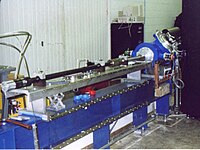
Photo from wikipedia
The atomistic mechanisms of damage initiation during high velocity (v up to 9 km s−1, kinetic energies up to 200 keV) impacts of W projectiles on a W surface have… Click to show full abstract
The atomistic mechanisms of damage initiation during high velocity (v up to 9 km s−1, kinetic energies up to 200 keV) impacts of W projectiles on a W surface have been investigated using parallel molecular-dynamics simulations involving large samples (up to 40 million atoms). Various aspects of the high velocity impacts, where the projectile and part of the target material undergo massive plastic deformation, breakup, melting, and vaporization, are analyzed. Different stages of the penetration process have been identified through a detailed examination of implantation, crater size and volume, sputtered atoms, and dislocations created by the impacts. The crater volume increases linearly with the kinetic energy for a given impactor; and the total dislocation length (TDL) increases with the kinetic energy but depends on the size of the impactor. We found that the TDL does not depend on the used interatomic potential. The results are rationalized based on the physical properties of bcc W.
Journal Title: Nuclear Fusion
Year Published: 2021
Link to full text (if available)
Share on Social Media: Sign Up to like & get
recommendations!